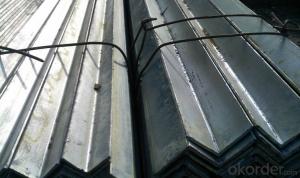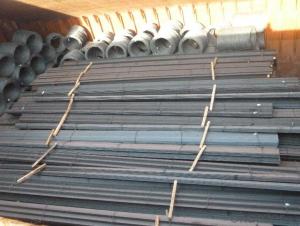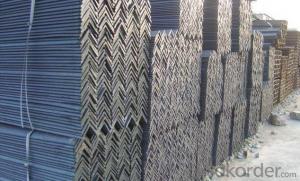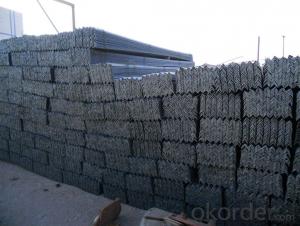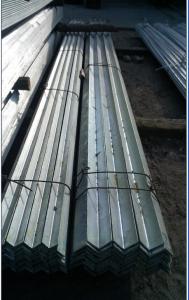GB Q235 Steel Angle with High Quality 30*30mm
- Loading Port:
- Tianjin
- Payment Terms:
- TT or LC
- Min Order Qty:
- 25 m.t
- Supply Capability:
- 10000 m.t/month
OKorder Service Pledge
OKorder Financial Service
You Might Also Like
Specifications of GB Q235 Steel Angle with High Quality 30*30mm:
1.Standards:GB
2.Length:6m, 12m
3.Material:Q235 or equivalent
4.Size:
Size (mm) | Mass (kg/m) | Size (mm) | Mass (kg/m) |
| 30*30*2.7 | 1.246 | 30*30*4 | 1.786 |
| 30*30*3.0 | 1.373 | 30*30*5 | 2.184 |
Usage & Applications of GB Q235 Steel Angle with High Quality 30*30mm:
Trusses;
Transmission towers;
Telecommunication towers;
Bracing for general structures;
Stiffeners in structural use.
Packaging & Delivery of GB Q235 Steel Angle with High Quality 30*30mm:
1. Transportation: the goods are delivered by truck from mill to loading port, the maximum quantity can be loaded is around 40MTs by each truck. If the order quantity cannot reach the full truck loaded, the transportation cost per ton will be little higher than full load.
2. With bundles and load in 20 feet/40 feet container, or by bulk cargo, also we could do as customers' request.
3. Marks:
Color mark: There will be color marking on both end of the bundle for the cargo delivered by bulk vessel. That makes it easily to distinguish at the destination port.
Tag mark: There will be tag mark tied up on the bundles. The information usually including supplier logo and name, product name, made in China, shipping marks and other information request by the customer.
If loading by container the marking is not needed, but we will prepare it as customers' request.
FAQ:
Q1: Why buy Materials & Equipment from OKorder.com?
A1: All products offered byOKorder.com are carefully selected from China's most reliable manufacturing enterprises. Through its ISO certifications, OKorder.com adheres to the highest standards and a commitment to supply chain safety and customer satisfaction.
Q2: How do we guarantee the quality of our products?
A2: We have established an advanced quality management system which conducts strict quality tests at every step, from raw materials to the final product. At the same time, we provide extensive follow-up service assurances as required.
Q3: How soon can we receive the product after purchase?
A3: Within three days of placing an order, we will arrange production. The shipping date is dependent upon the quatity, how many sizes you want and the plan of production, but is typically 30 to 45 days from the beginning of production.
Images of GB Q235 Steel Angle with High Quality 30*30mm:


*If you would like to get our price, please inform us the size, standard/material and quantity. Thank you very much for your attention.
- Q: What is the maximum load capacity of a steel angle?
- The maximum load capacity of a steel angle depends on various factors such as the dimensions, thickness, and quality of the steel angle. It is essential to consult engineering specifications or contact a structural engineer to determine the specific maximum load capacity for a particular steel angle.
- Q: What are the typical lengths of steel angles?
- Steel angles come in a range of lengths depending on their intended purpose and use. Generally, they are found in standard sizes of 20 feet or 6 meters, which are favored by manufacturers and construction firms for their convenience and easy transport. Moreover, steel angles can be tailored to meet the specific length requirements of a particular project.
- Q: Are steel angles suitable for playground equipment?
- Indeed, playground equipment can be made from steel angles as they possess the necessary attributes of strength, durability, and versatility. These angles are frequently employed in the construction of playground equipment due to their ability to endure rigorous usage and withstand the weight of numerous children. By conveniently welding or bolting steel angles together, a solid framework can be established, enabling the creation of an array of playground structures like climbing frames, swings, and slides. Moreover, the galvanization of steel angles serves to shield against corrosion, thereby prolonging the lifespan of the playground equipment and guaranteeing the safety of children during playtime.
- Q: Can steel angles be used for support columns in building construction?
- Yes, steel angles can be used for support columns in building construction. Steel angles are commonly used in construction due to their strength, durability, and versatility. They provide excellent support and stability when used as columns, especially in small to medium-sized buildings. Additionally, steel angles are easy to fabricate and can be customized to meet specific design requirements. They are also resistant to fire, corrosion, and pests, making them a reliable choice for support columns in building construction.
- Q: How do steel angles contribute to the overall durability of a structure?
- Steel angles, also known as angle irons or L-shaped structural steel, play a significant role in enhancing the overall durability of a structure. These versatile components are commonly used in construction projects due to their ability to provide strength, stability, and support. Firstly, steel angles are designed to withstand heavy loads and forces. By distributing the weight evenly, they help to prevent structural failures and ensure the longevity of the building. This is particularly important in applications where the structure is subjected to dynamic forces such as wind, earthquakes, or heavy machinery. Moreover, steel angles serve as effective reinforcements in critical areas of a structure. They are often used to reinforce connections between different structural members, such as beams and columns, creating a robust framework. This reinforcement enhances the overall load-bearing capacity of the structure, allowing it to withstand greater loads without compromising its integrity. Additionally, steel angles provide lateral stability to a building. By connecting various components diagonally, they help to resist horizontal forces, such as those caused by wind or seismic activity. This lateral stability is crucial in preventing the structure from swaying or collapsing under extreme conditions, ultimately ensuring the safety of occupants. Furthermore, steel angles are highly resistant to corrosion, which is a common cause of deterioration in structures. The use of galvanized or stainless steel angles can significantly reduce the risk of rusting and subsequent degradation. This corrosion resistance contributes to the long-term durability of the structure, reducing maintenance costs and prolonging its lifespan. In summary, steel angles are essential in enhancing the overall durability of a structure due to their ability to withstand heavy loads, provide reinforcement, offer lateral stability, and resist corrosion. By incorporating steel angles into construction projects, engineers can ensure the structural integrity and longevity of buildings, ultimately creating safer and more durable spaces.
- Q: Can steel angles be used in modular construction?
- Yes, steel angles can be used in modular construction. Steel angles are commonly used in modular construction as they provide structural support and stability. They can be used to create frames, beams, and columns, which are essential components in modular construction. Steel angles are known for their strength and durability, making them well-suited for withstanding the loads and stresses that modular buildings may experience. Additionally, steel angles can be easily fabricated, cut, and welded to meet the specific requirements of a modular construction project. Overall, steel angles are a versatile and reliable choice for modular construction applications.
- Q: What are the different types of steel angles used in structural engineering?
- There are several types of steel angles commonly used in structural engineering, including equal angles, unequal angles, L-shaped angles, and T-shaped angles. Each type has its own specific applications and structural purposes.
- Q: What are the common connection methods for steel angles?
- Depending on the specific application and structural requirements, steel angles have several common connection methods available. One commonly utilized method is welding. Steel angles can be joined together through various welding techniques, such as arc welding or MIG welding. This connection method ensures a robust and long-lasting bond between the angles. Bolting is another prevalent approach. By using bolts, nuts, and washers, steel angles can be securely connected. This method allows for easy disassembly and reassembly if necessary, making it ideal for situations where adjustments or replacements may be required in the future. For steel angles subjected to shear or tension forces, riveting is a reliable connection method. Rivets are employed to link the angles together, resulting in a strong and dependable connection. In certain cases, adhesive bonding can be used to connect steel angles. Specialized adhesives are employed to create a sturdy bond between the angles. This method is particularly useful when welding or bolting is not feasible or desired. When selecting the appropriate connection method for steel angles, it is important to consider factors such as load capacity, structural integrity, and the specific requirements of the project. Consulting with a structural engineer or a professional in the field is recommended to ensure the optimal connection method is chosen for a particular application.
- Q: Can steel angles be used for HVAC systems?
- Steel angles have the capability to be utilized in HVAC systems. Due to their strength and versatility, steel angles are frequently employed in construction and engineering applications. In the realm of HVAC systems, steel angles have numerous applications including providing support for ductwork, securing equipment, and establishing ventilation system frameworks. Steel angles possess durability, corrosion resistance, and the ability to withstand the weight and pressure of HVAC components. Moreover, they can be effortlessly welded or bolted together to form personalized structures and configurations. In conclusion, steel angles are an appropriate selection for HVAC systems due to their strength, durability, and design flexibility.
- Q: Can steel angles be used in temporary or modular structures?
- Indeed, temporary or modular structures can make use of steel angles. These angles are frequently employed in construction owing to their strength, adaptability, and affordability. Their primary function is to offer structural support and stability in a wide array of applications, including temporary or modular structures. The versatility of steel angles lies in their ease of cutting, welding, and bolting, allowing for convenient assembly and disassembly of such structures. Furthermore, steel angles possess the ability to endure substantial loads and provide exceptional resistance against bending and twisting forces, guaranteeing the stability and safety of the structure.
Send your message to us
GB Q235 Steel Angle with High Quality 30*30mm
- Loading Port:
- Tianjin
- Payment Terms:
- TT or LC
- Min Order Qty:
- 25 m.t
- Supply Capability:
- 10000 m.t/month
OKorder Service Pledge
OKorder Financial Service
Similar products
Hot products
Hot Searches
Related keywords
